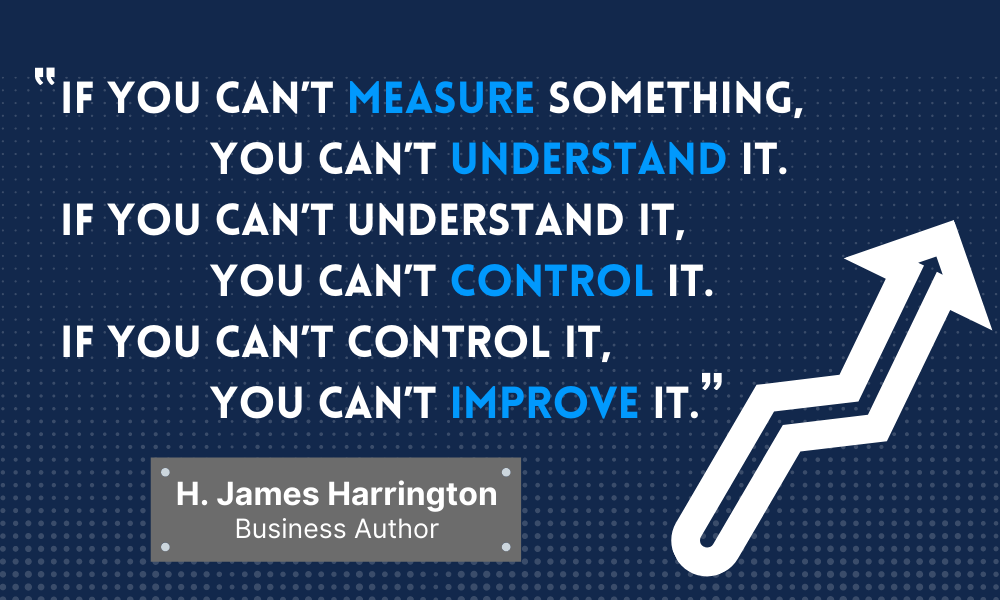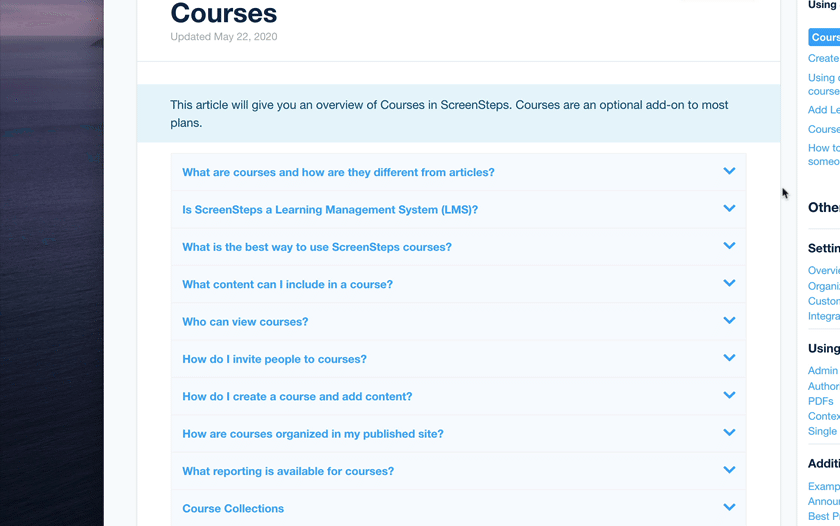How to convince your boss to switch your knowledge base to ScreenSteps
Is your knowledge base actually worth the amount of money, time, and effort you put into it?
For you to receive a good return on your investment, your knowledge base should be an active part of your company.
A good knowledge base is a one-stop-shop for all of your employees’ questions and answers. And the key is that your employees actually use it.
You recognize that your knowledge base isn’t working for your company’s needs and you believe ScreenSteps is the solution. But your boss wants you to use your existing knowledge base because adding another technology seems like an unnecessary expense.
As the co-founder of ScreenSteps, I’ve seen this struggle many times. We created ScreenSteps to fill in the spaces where other knowledge bases may have missed the mark.
We know you want to use ScreenSteps as your knowledge base, but you need approval. If you are going to convince your boss to switch to Screensteps, you are going to have to show the ROI (Return On Investment) to justify the cost.
If you need help convincing your boss to switch to ScreenSteps, this article will help you identify and explain four indicators that your current knowledge base isn’t working. Then we’ll show how you can make a case that ScreenSteps will have a higher ROI than your existing knowledge base.
Show your boss the ways your knowledge base isn’t working
So you have a knowledge base and you are filling it with information and resources. That’s great!
Because you’ve been part of the project, you know that your current knowledge base isn’t working. But, does your boss feel the same way?
If your boss already recognizes that your knowledge base is not working, then you can skip this section.
If your boss doesn’t believe you have a problem with your knowledge base, then it’s up to you to show how knowledge bases differ and where your current knowledge base is affecting your business.
Here are four ways businesses have found that their knowledge bases have fallen short.
1. It takes more than a day to update content
When you change a procedure, how long does it take your company to update your guides and get the notice out to all of your employees?
If the answer is anything more than a day, that is too long.
You probably know how long it takes to update your guides, but your boss probably doesn’t realize how many hours and days are lost to refreshing guides. Here’s how you can break down the process for your boss.
When there are changes that affect the operations of a company, those changes need to be communicated immediately.
Often, companies use their knowledge base as a dumping ground. They upload their Word Docs, PDFs, and PowerPoints to the knowledge base. Then employees have to download that information to their desktops in order to access it.
The problem is that even when you update the documents, employees often accidentally work out of old procedures. This is often because (1) it takes a long time to replace screenshots in guides or (2) people downloaded guides and are unaware of updates.
Any small change in a procedure can make a big difference, so you don’t want your employees working out of “How to cancel a subscription” version 2.2 when they should be in version 2.3.
When you are creating documents from scratch, how long does it take? Just like with updating procedures, you shouldn’t be spending weeks or months on one guide.
If a guide is needed, it is most likely that it is needed TODAY. Not tomorrow, not next week, but for operations your employees are handling today.
2. Employees can’t find guides in your knowledge base
You’ve taken the time to create guides, but your employees can’t find them in your knowledge base.
Essentially, all of that time and work you’ve put into creating those guides is wasted. Your articles might as well be hanging out in a black hole when no one knows how to access them.
If your company is spending money on a software that isn’t getting used, your boss will want to know, especially come budgeting season. From a budgeting perspective, this means there is no ROI on all the man hours spent on creating those guides.
 When it is difficult to find the guides, employees will not use them. It is frustrating to shuffle through documents and still not find what you are looking for.
When it is difficult to find the guides, employees will not use them. It is frustrating to shuffle through documents and still not find what you are looking for.
How do you know if your employees can find things in your knowledge base?
One indicator that they can’t find guides is that they keep sticky notes on their desktops or they have multiple documents open at all times. If they can find the articles quickly, then they wouldn’t need to have everything they need in view at all times.
🔎 Related: Should I replace my Sharepoint Knowledge Base with ScreenSteps?
3. The guides aren’t helpful
While we know you can write great content, the tools you are using make it difficult to present that content in a way your employees can easily understand.
It could be that you aren't using enough screenshots because it simply takes too long to add images to an article and keep them up to date.
Or maybe the procedures you are documenting are long and complex. You don't have tools that allow you to show or hide content based on what the reader needs to see.
Without those tools, you’re like a concert pianist without a functioning keyboard. You can play all of the right notes, but the piano is out of tune and has 10 broken keys so the song won’t sound right.
Ideally, you want your employees to be able to follow a guide in real time, no matter how much experience they have.
For call center employees, this means that they should be able to use a guide to help a customer without ever having to put the customer on hold.
When employees are able to follow a guide the first time using it, it saves time and reduces the number of employees you need to staff.
4. You have no way to track if your employees are using your knowledge base
Do you know if your employees are using your knowledge base guides? How often do your employees use them? Do they turn to your knowledge base when they have questions?
You need to be able to track how (or even if) your employees are using your knowledge base so that you can prove its worth (or lack thereof) to your boss.
If you aren’t tracking usage, then your knowledge base might as well be sitting on an isolated island all alone.
You need metrics to determine if your guides are working.
Help your boss understand that it doesn’t help to fill your guide with resources and let all the content sit there. Your knowledge base has a purpose — to help your employees by providing answers to your company’s policies and procedures.
When you track how your knowledge base is being used, then you are able to make adjustments to your guides so that they can better aid your employees.
If your knowledge base doesn’t have this capability, you need a new knowledge base.
Make a case for how the ScreenSteps knowledge base can help
Does your company deal with the above knowledge base shortcomings?
If no, then it’s working and there is no reason to look at ScreenSteps.
If, however, you identify with the four signs listed above, then ScreenSteps may help with your struggling points.
Once you’ve made a case for how your current knowledge base is broken, then you can use these six points to show them how ScreenSteps will have a better ROI than your existing knowledge base.
1. Show how you can track ROI and usage
Analytics are an important part of your knowledge base, and yet, many knowledge bases don’t provide usage statistics.
Prolific business author H. James Harrington said, "Measurement is the first step that leads to control and eventually to improvement. If you can’t measure something, you can’t understand it. If you can’t understand it, you can’t control it. If you can’t control it, you can’t improve it.”

If you aren’t tracking usage, you won’t know if your knowledge base is doing its job. This is the evidence you’ll be able to show your boss that ScreenSteps is worth the investment.
ScreenSteps provides analytics so that you can measure usage. You can see who is using your knowledge base, how they are using it, and what articles they are using.
This helps you know if you need to update or clarify a step in your processes.
For example, if your analytics show that your employees are using your guide for “How to reschedule an eye doctor appointment,” but they keep forgetting to cancel the original appointment, then you can go into the guide and add a step so that they cancel the appointment.
Then you can follow analytics to ensure the changes solve the problem.
Analytics can also help correct employee behaviors and reduce unnecessary mistakes.
If you see an employee, Tim, is always making a mistake during calls associated with upgrading cell phone service, then you can see what articles Tim has been using on those calls. If analytics show Tim isn’t using a guide, then you can correct his behavior so he uses the guides regularly.
We’ve seen a direct correlation between performance scores and how frequently an employee uses the articles in ScreenSteps. As employees reference the guides, they make fewer mistakes.
2. Show how the communication process is smoother
It’s easy to create documents from scratch using our robust collection of content creation tools. This makes it easier to communicate assignments and changes with your team.
When you create a system (or style guide) that your company uses for formatting articles, you can have a whole team of content authors. Using Author Management tools, you can assign articles to employees to write and provide feedback before publishing.
This allows you to use your team of experts to write articles for the areas that they know best.
Plus, you can create templates for content authors to use that also help speed up the content creation process.
Another way to help your boss understand the benefits of switching to ScreenSteps is by sharing one of our case studies. One business was able to create 4X the documents in ¼ of the time by using ScreenSteps’ documentation tools.
3. Show how productivity will increase
A leader’s role is centered around optimizing the business. Your boss needs to get the most out of the allotted budget, the most out of each employee’s time, and the most out of your software.
That is measured in productivity. With ScreenSteps, productivity is higher. Information is communicated faster, content is created quicker, employees save time, and accessibility to resources increases.
How do you illustrate that promise to your boss?
Frame the challenge: Your employees currently have to wait days or weeks for guides that they need to do their job today.
Then explain how ScreenSteps is the solution to that challenge: Depending on how in-depth an update is, it can take as little as a few minutes or hours with ScreenSteps.
That’s because ScreenSteps uses simple tools to clearly create articles, including arrows, foldable sections, checklists, and more.
Once an update is published, employees can immediately start using the updated guide. The outdated version will no longer be available for them. (However, older versions of your guides are saved so that you and your authors can rollback changes or view past revisions if you ever need to.)
4. Show how it empowers employees to work independently and more efficiently
Often what happens with teams in a company is that a team manager is stuck micromanaging because employees have questions they can’t find the answers to. This means two people are often doing one job. That’s a red flag on efficiency.
A company is built on organization and people fulfilling specific roles. Show your boss how ScreenSteps can help increase employees’ confidence and encourage them to work independently.
This frees up your team managers so that they can work on higher level projects that they can never get to because they are always answering questions from their team.
You do this by making it easy for your employees to find your guides.
The company has invested a lot of time and money into filling your knowledge base with helpful resources for your employees. If people can find what they need, they ask fewer questions and make fewer mistakes. It’s a win-win scenario.
The ScreenSteps knowledge base is easy to use. It works like an internal search engine for your company’s policies and procedures.
When you download the Chrome Browser Extension, searching becomes even easier. Using keywords, employees can type in the search bar and suggested articles pop up according to which web page your employees are on.
They don’t have to leave the page they are at to find the answers they need.
That means that if your employee is working on the invoicing screen and they need to know, “what to do if an invoice number is missing.” They can click the blue bell on the side of the screen, type the question in the bar, and only invoice page-specific articles will appear.
These tools dramatically shorten search time and increase the ability to find the answers. Whereas one of our clients used to take 5 or more clicks to get to the document they needed, it now only takes them 2 clicks.
5. Show how employees will make fewer costly mistakes
Mistakes are disappointing, but it becomes even more painful when they are costly.
One client came to us because they were having issues with their employees making mistakes when they would cost medical equipment when it didn’t need to be switched out. Every time the employee mistakenly processed a trade that didn’t need to happen, it cost the company $1,000.
When a knowledge base doesn’t have the proper content creation tools, it makes it more difficult to follow a guide.
ScreenSteps offers three different types of guides that make it easy to communicate a process. Those three article types are Standard Articles, Interactive Checklists, and Workflow Articles.
In these articles, there are tools that use both word and visual cues to direct an employee through a process. These tools include arrows, checklists, integrated screenshots, and more.
If they need more information, there are foldable sections so that they can expand a note for further information.

The point is that our robust content creation tools turn confusion and chaos into easy-to-follow, step-by-step instructions that minimize costly mistakes. Just like in the case of our client, it could save you thousands of dollars.
6. Show how employee usage will skyrocket
Your company and boss don’t want to invest in something that your company isn’t going to use.
That means you need a knowledge base that your employees can rely on. That way they’ll want to use the knowledge base.
Think about a person you rely on. They are typically your most trusted friend. That person is who if you were on “Who Wants to Be a Millionaire?” you’d want on standby for your “Phone a Friend.”
ScreenSteps is your reliable, trustworthy, phone-a-friend knowledge base.
There’s no PhD required to work in ScreenSteps. When you fill ScreenSteps with your guides, we make it easy and simple for your employees to use ScreenSteps.
It’s like other knowledge bases where it has all the content and authors. But the one major difference is it is reformatted for easier use, so employees actually use it.
We’ve seen usage skyrocket when our clients have launched ScreenSteps in their companies. In a 30-day period, here are a few usage statistics from our current clients:
- 600 employees viewed ScreenSteps 102,615 times at a credit union
- 118 employees viewed ScreenSteps 9,507 times at a major metropolitan hospital
- 45 employees viewed ScreenSteps 27,127 times at a regional health care provider
In these cases, these are hundreds of thousands of times where employees could have asked a manager a question, but instead they found the answer quickly on their own. These are situations where employees avoided making mistakes.
When employees know they will find the answers to their questions in your knowledge base, then they will rely on it.
Ultimately, that shows that the investment in a knowledge base was worth the expense.
How ScreenSteps will impact your business
If you are facing any of the above issues, despite having a knowledge base, ScreenSteps could be the right change for you.
Prove to your boss that ScreenSteps will provide a strong ROI for your company with tools that generate increased productivity, decreased mistakes, and reduced training time. Plus, it will decrease employee stress and confusion.
ScreenSteps provides you with the tools your team needs to create reliable guides, easily access those guides, and then analyze how those guides are used. With these tools, you can improve your content and know that your investment is working.
If you need more resources or explanations to help you show why ScreenSteps is right for your company, schedule a meeting with one of our representatives. They can help you understand how ScreenSteps can help in your unique situation.



